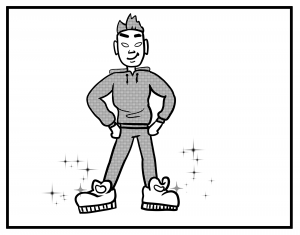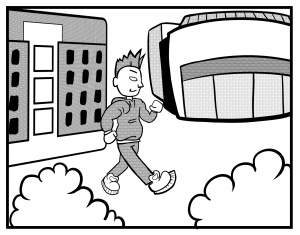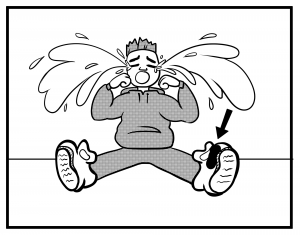59 A-2: FRED UND SEIN SCHUH/FRED AND HIS SHOE
A-2: FRED UND SEIN SCHUH/FRED AND HIS SHOE
Story notes:
This story reuses the three ‘super special’ and a few ‘special’ verbs you already know. Make sure you know them really, really, I mean really well. They are covered in the Grammar part.
You will also see a few new constructions, such as:
-
-
-
- separable verbs ;
- ‘tricky’ verbs;
- verb-kickers.
-
-
But don’t worry, you don’t need to become an expert on these topics quite yet! Check out these sections only in you are a language nerd like me and really want to know what exactly is going on here. But you don’t have to do that. As long as you understand the story, keep doing what you were doing and we will deal with each of these topics later in the course.
After the text of the story, I list a few short sections you will want to check out to make things a bit more clear from structural standpoint.
__________________________________________________________________________________________
auch – also
bekommt – receives
das Geld – money
hat gekauft – has bought
seine Schuhe – his shoes
glänzen – glow/shine
stolz auf – proud of
sieht toll aus – looks good
viele – many (as opposed to viel – much)
da – there (the same as dort)
zeigen – to show
sehr langsam – very slow(ly)
damit – so that (v-kickers)
tritt auf – steps on
wird traurig – becomes said
Here is the story audio.
Fred ist ein cooler junger Mann. Er studiert auch an McMaster.

Er kommt aus Mississauga und studiert Kommerz im sechsten Semester. Er ist ein Bro. Fred bekommt OSAP. Von dem OSAP Geld hat er ein neues Handy und neue Schuhe gekauft. Er mag seine Schuhe sehr. Seine Schuhe sind weiß und sie glänzen! Fred ist sehr stolz auf sein Handy und seine Schuhe. Er denkt, er sieht toll aus. Er sagt: “Ja, Baby, ich sehe toll aus!”
 Am ersten Tag des Semesters geht Fred ins Studentenzentrum. Viele Studenten und Studentinnen sind da. Er will seinen Bros seine Schuhe und sein Handy zeigen. Er geht sehr langsam, damit alle seine neuen weißen Schuhe und sein neues Handy sehen.
Am ersten Tag des Semesters geht Fred ins Studentenzentrum. Viele Studenten und Studentinnen sind da. Er will seinen Bros seine Schuhe und sein Handy zeigen. Er geht sehr langsam, damit alle seine neuen weißen Schuhe und sein neues Handy sehen.
Rita ist auch im Studentenzentrum. Sie will Kaffee kaufen. Sie geht sehr schnell.  Sie denkt an das Waschbärbaby, sieht Fred nicht und tritt auf seinen Schuh. Der Schuh ist kaputt! Er ist nicht mehr weiß und er glänzt nicht mehr!
Sie denkt an das Waschbärbaby, sieht Fred nicht und tritt auf seinen Schuh. Der Schuh ist kaputt! Er ist nicht mehr weiß und er glänzt nicht mehr!
Fred wird sehr traurig. Er beginnt zu weinen. Er will nicht weinen, aber er weint.
_____________________________________________________________
Aufgaben
Aufgabe 1. Beantworten Sie die Fragen mit kurzen Antworten / Answer the questions with short answers from the story.
Was hat sich Fred vom OSAP Geld gekauft? _________________________________
Welche Farbe haben seine Schuhe? _________________________________
Sieht Fred gut aus? _________________________________
Wann geht Fred ins Studentenzentrum? _________________________________
Was will er seinen Bros zeigen? _________________________________
Was will Rita im Studentenzentrum? _________________________________
Tritt Rita auf Freds Schuhe oder auf sein Handy? _________________________________
Was macht Fred? _________________________________
Will er weinen? _________________________________
Aufgabe 2. Rita telefoniert mit ihrer Mutter. Sie erzählt ihr über das Waschbärbaby, aber ihre Mutter glaubt ihr nicht. Welche Form passt? Rita is on the phone with her mother. She is telling her about the baby-racoon, but her mom doesn’t believe any of it. Which verb form is correct?
– haben – habe – hast – hat – heißt – heiße – ist – bist – bin –
Rita: Hallo! Mutti, ich ________ ein Waschbärbaby gefunden! (1)
Mutter: Wie bitte? (2) Was ________ du gefunden?
Rita: Ein Waschbärbaby! Ich _________ ein Haustier! (3)
Mutter: Du _________ ein Waschbärbaby als Haustier?
Rita: Ja, ich _________ ein Waschbärbaby als Haustier! Ich ____ so froh!
Mutter: Du ___________ komisch. (4) ______ er einen Namen?
Rita: Ja, er ________ Glückwunsch. Er ______ sehr klein und süß.
Mutter: Warte, warte! Du ___________ ein Waschbärbaby als Haustier, er _______ klein und süß, und er ________ Glückwunsch?
Rita: Ja, Mutter, ich ___________ ein Waschbärbaby als Haustier, er ____________ klein und süß, und er ___________ Glückwunsch.
Mutter: Aber das _________ dumm! Nein, du verarschst mich. (5) Tschüß!
1. Found 2. Pardon me? 3. Pet (House animal) 4. Weird 5. You are kidding me
Aufgabe 3. Welche Antwort ist richtig?… Which answer is right?
1) Fred studiert __________ an der Uni.
a) Biologie
b) Kommerz
c) Philosophie
d) nichts
2) Was bekommt Fred?
a) NOSAP
b) ASAP
c) OSAP
d) ein böses Erwachen
3) Was hat Fred gekauft?
a) Schuhe
b) Schuhe und ein Handy
c) einen Hund
d) ein Laptop
4) Fred denkt, er ________ sehr _______ aus.
a) sieht, toll
b) ist, schrecklich
c) toll, sieht
d) weint, laut
5) An welchem Tag geht Fred ins Studentenzentrum?
a) am vierten
b) am sechsten
c) am ersten
d) am neunzehnten
6) Rita ist ______ an McMaster.
a) alt
b) groß
c) klein
d) neu
7) Rita wohnt in einem _________________.
a) Sternbocks
b) Studentenzentrum
c) Studentenheim
d) Café
8) Das Waschbärbaby heißt ____________.
a) Fußboden
b) Geld
c) Glückwunsch
d) Schuh
9) Fred mag seine Schuhe, weil sie __________.
a) glänzen
b) nehmen
c) denken
d) trinken
10) Fred weint, weil sein Schuh nicht mehr _____________ ist.
a) blau
b) rot
c) braun
d) weiß
Aufgabe 4. Compound Animals
Combine the words for animals from the list below to create your own unique creatures. Go wild, nothing is impossible in this exercise!
Don’t forget, if a word ends in an -e, give it an extra -n ending:
Lowe + Schwein – Löwenschwein but Schwein + Löwe – Schweinlöwe
|
Wespe |
Giraffe |
Ratte |
Löwe |
1. ___________________________________________________ |
|
Maus |
Kobra |
Schwan |
Tiger |
2. ___________________________________________________ |
|
Fuchs |
Wal |
Kuh |
Krokodil |
3. ___________________________________________________ |
|
Kamel |
Wolf |
Bär |
Schwein |
4. ___________________________________________________ |
|
Känguru |
Wurm |
Pinguin |
Delphin |
5. ___________________________________________________ |
Aufgabe 5. Will, mag, oder kann? Unscramble the following sentences to match with the events of the stories A-1 and A-2! Unscramble the final sentence to uncover something secret about Rita’s past….
Kaffee/trinken/Rita/mag
heißt/das Waschbärbaby/Glückwunsch
Weinen/Fred/nicht/will
Fred/mag/Schuhe/seine
seinen Bros/das Handy/zeigen/er/will
Rita mag Haustiere, aber …. /ist /sie /keine gute/ Haustierbesitzerin (1)
1. Pet owner
Aufgabe 5. Persönliche Fragen Personal questions
- Wie trinken Sie Kaffee: schwarz wie die Nacht, süß und blond, oder nur mit Milch?
- Sind Sie auch ein cooler Bro, wie Fred?
- War es dumm von Fred, neue Schuhe und neues Handy mit seinem OSAP Geld zu kaufen?
- Was ist besser als Haustier: eine Katze oder ein Waschbär?
- Trinkt Rita zu viel Kaffee jeden Tag?
- Wie viele Liter Kaffee trinken Sie jeden Tag?
- Wollen Sie auch glänzend-weiße Schuhe?
- Weinen Sie, wenn jemand (someone) auf ihren Schuh tritt?
Lösungsschlüssel / Answer Key
A-2. Aufgabe 1: 1. ein neues Handy und neue Schuhe. 2. Sie sind weiß. 3. Er denkt, er sieht gut aus. 4. Am ersten Tag des Semesters. 5. seine Schuhe und sein Handy. 6. Kaffee trinken. 7. auf seinen Schuh. 8. er weint. 9. Nein, er will nicht weinen.
A-2. Aufgabe 2: habe, hast, habe, hast, habe, bin, bist, hat, heißt, ist, hast, ist, heißt, habe, ist, heißt, ist.
A-2. Aufgabe 3: 1b; 2c; 3b; 4a; 5c; 6d; 7c; 8c; 9a; 10d.
A-2. Aufgabe 4: 1. Rita mag Kaffee trinken; 2. Das Waschbärbaby heißt Glückwunsch; 3.Fred will nicht weinen; 4. Fred mag seine Schuhe; 5.Er will seinen Bis das Handy zeigen.
A-2. Aufgabe 5: example answers: 1. Ich trinke Kaffee schwarz; 2. Nein, ich bin kein Bro, wie Fred. 3. Ja, es war sehr dumm von Fred! 4. Eine Katze ist besser als Haustier, aber ein Waschbär ist cooler! 5. Ja, sie trinkt zu viel Kaffee. 6. Ich trinke 0.5 Liter Kaffee jeden Tag. 7. Nein, ich will weiße Schuhe nicht. 8. Ja, ich weine, wenn jemand auf meinen Schuh tritt.
